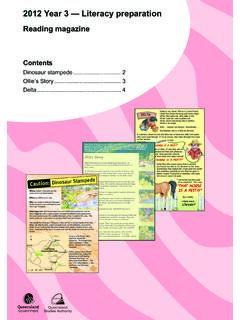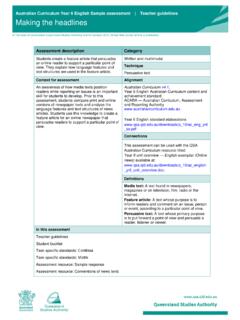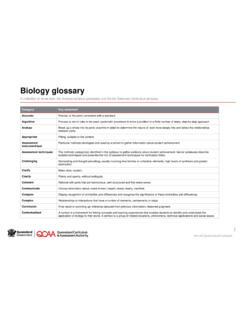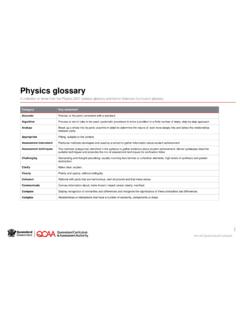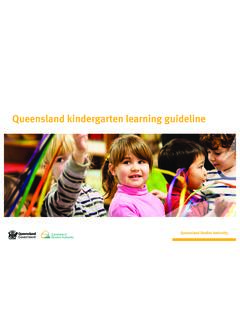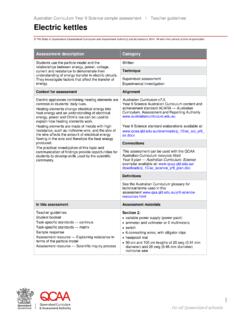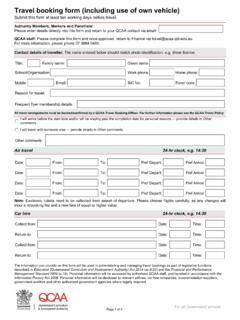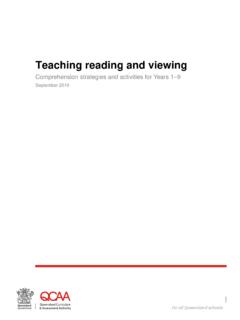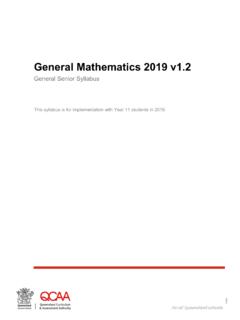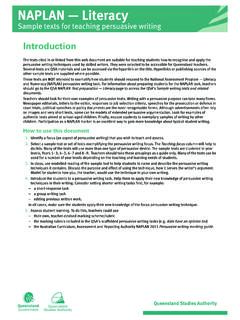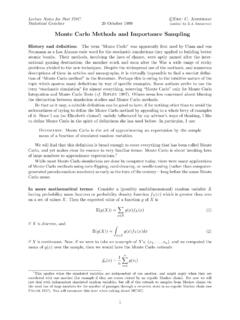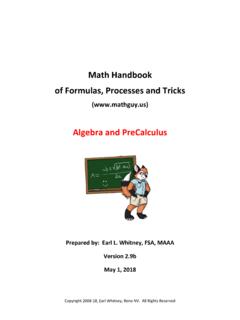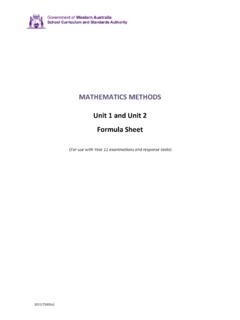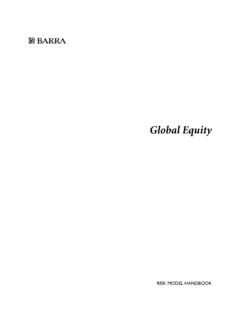Transcription of Mathematical Methods 2019 v1 - Queensland Curriculum and ...
1 Mathematical Methods 2019 General Senior Syllabus This syllabus is for implementation with Year 11 students in 2019. 170089 Contents 1 Course overview _____ 1 Introduction .. 1 Rationale .. 1 Learning area structure .. 3 Course structure .. 4 Teaching and learning .. 5 Syllabus objectives .. 5 Underpinning factors .. 6 Aboriginal perspectives and Torres Strait Islander perspectives .. 9 Pedagogical and conceptual frameworks .. 10 Subject matter .. 15 Assessment general information .. 16 Formative assessments Units 1 and 2 .. 16 Summative assessments Units 3 and 4 .. 16 Reporting standards.
2 17 2 Unit 1: Algebra, statistics and functions _____ 19 Unit description .. 19 Unit objectives .. 19 Topic 1: Arithmetic and geometric sequences and series 1 .. 20 Topic 2: Functions and graphs .. 20 Topic 3: Counting and probability .. 21 Topic 4: Exponential functions 1 .. 22 Topic 5: Arithmetic and geometric sequences and series 2 .. 22 Assessment guidance .. 22 3 Unit 2: Calculus and further functions _____ 23 Unit description .. 23 Unit objectives .. 23 Topic 1: Exponential functions 2 .. 24 Topic 2: The logarithmic function 1 .. 24 Topic 3: Trigonometric functions 1 .. 24 Topic 4: Introduction to differential calculus.
3 25 Topic 5: Further differentiation and applications 1 .. 25 Topic 6: Discrete random variables 1 .. 26 Assessment guidance .. 26 4 Unit 3: Further calculus _____ 27 Unit description .. 27 Unit objectives .. 27 Topic 1: The logarithmic function 2 .. 28 Topic 2: Further differentiation and applications 2 .. 28 Topic 3: Integrals .. 29 Assessment .. 30 Summative internal assessment 1 (IA1): Problem-solving and modelling task (20%) .. 30 Summative internal assessment 2 (IA2): Examination (15%) .. 34 Summative external assessment (EA): Examination (50%) .. 38 5 Unit 4: Further functions and statistics _____ 39 Unit description.
4 39 Unit objectives .. 39 Topic 1: Further differentiation and applications 3 .. 40 Topic 2: Trigonometric functions 2 .. 40 Topic 3: Discrete random variables 2 .. 40 Topic 4: Continuous random variables and the normal distribution .. 41 Topic 5: Interval estimates for proportions .. 41 Assessment .. 43 Summative internal assessment 3 (IA3): Examination (15%) .. 43 Summative external assessment (EA): Examination (50%) .. 47 6 Glossary _____ 50 7 References _____ 74 8 Version history _____ 76 Mathematical Methods 2019 General Senior Syllabus Queensland Curriculum & Assessment Authority July 2018 Page 1 of 76 1 Course overview Introduction Rationale Mathematics is a unique and powerful intellectual discipline that is used to investigate patterns, order, generality and uncertainty.
5 It is a way of thinking in which problems are explored and solved through observation, reflection and logical reasoning. It uses a concise system of communication, with written, symbolic, spoken and visual components. Mathematics is creative, requires initiative and promotes curiosity in an increasingly complex and data-driven world. It is the foundation of all quantitative disciplines. To prepare students with the knowledge, skills and confidence to participate effectively in the community and the economy requires the development of skills that reflect the demands of the 21st century. Students undertaking Mathematics will develop their critical and creative thinking, oral and written communication, information & communication technologies (ICT) capability, ability to collaborate, and sense of personal and social responsibility ultimately becoming lifelong learners who demonstrate initiative when facing a challenge.
6 The use of technology to make connections between Mathematical theory, practice and application has a positive effect on the development of conceptual understanding and student disposition towards mathematics. Mathematics teaching and learning practices range from practising essential Mathematical routines to develop procedural fluency, through to investigating scenarios, modelling the real world, solving problems and explaining reasoning. When students achieve procedural fluency, they carry out procedures flexibly, accurately and efficiently. When factual knowledge and concepts come to mind readily, students are able to make more complex use of knowledge to successfully formulate, represent and solve Mathematical problems.
7 Problem-solving helps to develop an ability to transfer Mathematical skills and ideas between different contexts. This assists students to make connections between related concepts and adapt what they already know to new and unfamiliar situations. With appropriate effort and experience, through discussion, collaboration and reflection of ideas, students should develop confidence and experience success in their use of mathematics. The major domains of mathematics in Mathematical Methods are Algebra, Functions, relations and their graphs, Calculus and Statistics. Topics are developed systematically, with increasing levels of sophistication, complexity and connection, and build on algebra, functions and their graphs, and probability from the P 10 Australian Curriculum .
8 Calculus is essential for developing an understanding of the physical world. The domain Statistics is used to describe and analyse phenomena involving uncertainty and variation. Both are the basis for developing effective models of the world and solving complex and abstract Mathematical problems. The ability to translate written, numerical, algebraic, symbolic and graphical information from one representation to another is a vital part of learning in Mathematical Methods . Students who undertake Mathematical Methods will see the connections between mathematics and other areas of the Curriculum and apply their Mathematical skills to real-world problems, becoming critical thinkers, innovators and problem-solvers.
9 Through solving problems and developing models, they will appreciate that mathematics and statistics are dynamic tools that are critically important in the 21st century. Mathematical Methods 2019 General Senior Syllabus Queensland Curriculum & Assessment Authority July 2018 Page 2 of 76 Assumed knowledge, prior learning or experience Assumed knowledge refers to the subject matter that teachers can expect students to know prior to beginning this subject. Emphasis is placed on the mastery of content, ensuring key concepts or procedures are learnt fully so they will not need reteaching. Developing mastery often involves multiple approaches to teaching and conceptualising the same Mathematical concept.
10 When students have a good understanding of a key concept or procedure, they are more easily able to make connections to related new subject matter and apply what they already know to new problems. Subject matter from previous unit/s is assumed for subsequent unit/s. The following is a non-exhaustive list of assumed knowledge from the P 10 Australian Curriculum that must be learnt or revised and maintained as required: factorise, expand and simplify algebraic expressions including monic quadratic expressions using a variety of strategies apply the four operations to simple algebraic fractions with numerical denominators substitute values into formulas to determine an unknown solve problems involving linear equations, including those derived from formulas and those that involve simple algebraic fractions recall the equation of a line in the form = + determine if lines are parallel or perpendicular lines.
